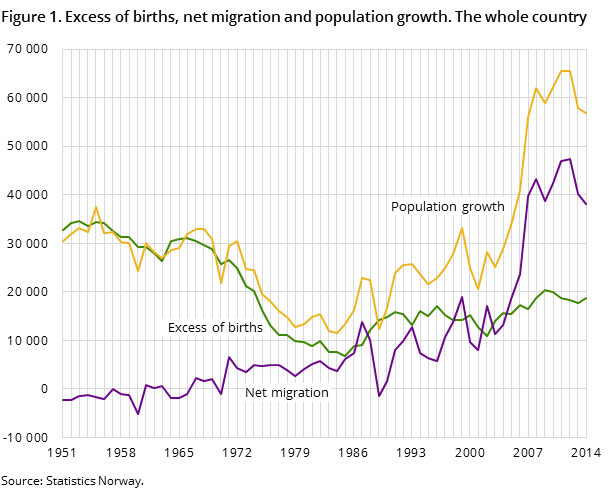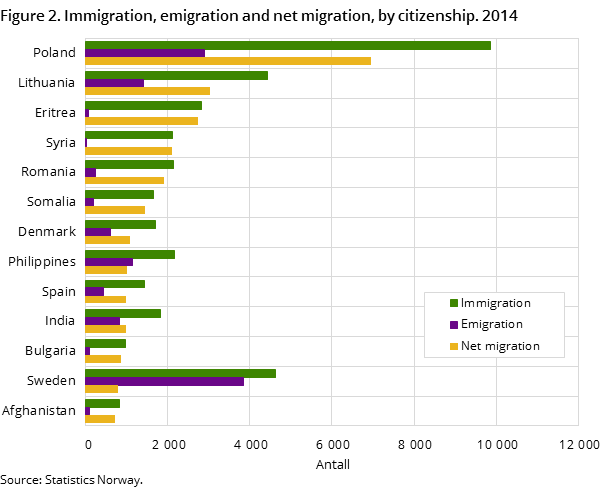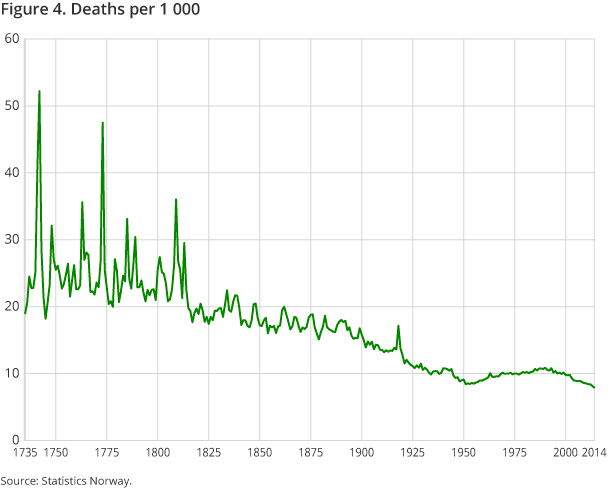Content
Published:
This is an archived release.
Lowest number of deaths for 37 years
In 2014, 59 100 children were born in Norway, which was about 100 more than the previous year. A total of 40 400 persons died, which was 900 fewer than in 2013. This was the lowest number of deaths since 1977, when Norway had one million fewer inhabitants.
| 4th quarter 2014 | 4th quarter 2013 | Changes from same period previous year | |
|---|---|---|---|
| Number | |||
| Population at the beginning of the quarter | 5 156 451 | 5 096 300 | 60 151 |
| Births | 13 358 | 13 425 | -67 |
| Deaths | 10 521 | 10 462 | 59 |
| Excess of births | 2 837 | 2 963 | -126 |
| Immigration | 16 073 | 17 956 | -1 883 |
| Emigration | 9 484 | 8 334 | 1 150 |
| Net migration, immigration and emigration incl | 6 589 | 9 622 | -3 033 |
| Population growth | 9 351 | 12 756 | -3 405 |
| Population at the end of the quarter | 5 165 802 | 5 109 056 | 56 746 |




In relation to the population size, the number of deaths in 1977 was 0.99 per cent, compared to 0.79 per cent in 2014. This is the lowest figure ever registered in our annual registrations, which date all the way back to 1735. One reason for this might be that there was no major outbreak of seasonal influenza in 2014, which would otherwise have affected vulnerable groups.
Increasing birth surplus
The birth surplus was 1 000 higher in 2014 than in 2013. This is higher than the last two years, and is the highest since the mid-1970s after the period 2008-2011.
The total fertility rate for 2014 was 1.76 compared to 1.95 in 2010. Nevertheless, Norway still has one of the highest fertility rates in Europe.
Both men and women saw a relatively large increase in life expectancy. A boy born in 2014 is expected to live for 80 years, while a girl can expect 84.1 years. This is an increase of half a year for girls and four months for boys compared to the previous year.
Lower immigration leads to lower population growth
The population increased by 56 750 persons last year, and at the beginning of 2015, there were 5 165 800 residents in Norway. The increase was 1 000 lower than in 2013 and 4 400 lower than the average for the years since 2007. Lower immigration from abroad is the main reason for this.
The population increase has been higher in all the years since 2008 than in 2014. Net immigration from abroad decreased from 40 100 in 2013 to 38 200 last year, and is the lowest since 2006. Net immigration remains high, and the total for the last eight years is 336 600, which is almost triple that of the total for the preceding eight years. A total of 70 000 immigrations were registered, which was 5 800 fewer than the year before. A total of 31 900 persons left the country, which was 3 800 fewer than in 2013.
Lower net immigration, but Syrian citizens are a new, large group
Net in migration of foreign citizens has decreased from 48 700 in 2012 to 41 900 in 2013 and 38 100 in 2014. Of this, 23 600 or 62 per cent were net immigrations by European citizens. In 2013, the figure was at the same level. Net immigration by non-European citizens decreased, from 18 000 in 2013 to 14 500 in 2014.
Citizens from nine countries had a net in migration of more than 1 000, and five of these countries are European. Polish and Lithuanian citizens still constitute the two largest groups, and represent 42 per cent of the European citizens. Persons with a refugee background from Eritrea and Somalia accounted for the third and sixth largest groups respectively. Syrian citizens represent a new and large group, and their net in migration of 2 100 makes them the fourth largest.
Among the countries with the largest in migration there were significant differences between the number of in migrations and out migrations. A total of 4 600 Swedish citizens immigrated – the second largest group – but 3 800 left Norway. The net in migration was therefore just 800. On the other hand, 2 100 Rumanian citizens immigrated, but only 200 left, giving a large net in migration of 1 900.
Oslo had almost 40 per cent of the population growth
All counties had a population growth in 2014, but 12 of the 19 counties had a smaller growth than in 2013. Oslo had the highest, with a total of 13 200 persons, which was 2 700 more than the previous year. The growth in the two counties Rogaland and Hordaland combined was 4 100 higher than in Oslo in 2013, while 2014 saw a fall in growth by 400 compared to Oslo. The growth in Akershus county was 9 100, and the growth in Oslo and Akershus combined represented 39 per cent of the total growth in Norway.
Large internal net migration to Akershus and Østfold
All counties had a total net migration surplus, with the highest in Akershus and Oslo. In order to show the disparities between counties, migration can be broken down into two categories - moving from and to abroad, and internal migration.
Nine counties had an internal migration surplus, i.e. more people moved in from other areas of the country than moved out to other areas of the country. However, only one area stood out; Akershus and Østfold, with 4 100 persons combined, which is 70 per cent of the total surplus for the counties that had a surplus. These are counties that not only have their own working places but also have a short commuter distance to Oslo. Ten counties had an internal migration loss, i.e. more people moved out to other areas of the country than moved in from other areas of the country.
Net in migration from abroad – in-migration from abroad minus out-migration to abroad - was clearly highest in Oslo in 2014, with 7 100. As a percentage of the population, the figure was highest in Oslo and two of the three northernmost counties; Finnmark and Troms. Net in migration from abroad outweighed the internal net migration loss and birth deficit. The population increased in all counties, but without the in migration surplus, it would have decreased in 9 of the 19 counties.
The statistics is published with Population.
Contact
-
Statistics Norway's Information Centre
E-mail: informasjon@ssb.no
tel.: (+47) 21 09 46 42
